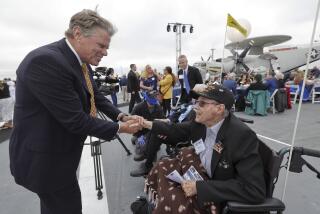Keeping the Confederate Navy’s History Afloat
- Share via
COLUMBUS, Ga. — As navies go, the Navy of Confederate States of America was short-lived. But its impact was felt in many ways.
With 130 ships, two admirals, and a few hundred officers--most of them former U.S. Navy men--it lasted only four years. And with only 5,000 sailors, the Navy of Confederate States was vastly outnumbered by a Northern fleet of 700 ships and 20,000 sailors.
Yet the Southern navy made its mark. The 40-foot CSS Horace L. Hunley, built in New Orleans, was the first submarine to sink an enemy ship, sending the USS Housatonic to the bottom of Charleston Harbor on Feb. 17, 1864.
Towing a torpedo filled with 90 pounds of gun powder at the end of a 200-foot line, the Hunley dove under the Housatonic and smashed the torpedo against the hull of the Union ship. The explosion also sunk the Hunley.
And it was the famous battle between the ironclads Monitor from the North and the Merrimack (a.k.a. Virginia) from the South that revolutionized the design of Navy ships worldwide. The duel between the Monitor and Merrimack of Hampton Roads ended in a draw.
Here in Columbus, on the banks of the Chattahoochee River, the Confederate Naval Museum commemorates the Navy of the Southern States. The centerpiece is the remains of two Confederate ships--the 225-foot ironclad Jackson and the 130-foot sail/steam gunboat Chattahoochee.
The city-owned and -operated museum is built around the hulls of the two ships, both salvaged and raised from the bottom of the Chattahoochee River. At war’s end, the gunboat Chattahoochee was scuttled 10 miles below Columbus to prevent her capture by Union troops.
Ship Set Afire
About the same time, the Jackson was nearing completion in the Confederate Navy Yard at Columbus when Union forces set the ship afire and cut her loose from her mooring. After drifting 30 miles downriver, the Jackson sank.
It took 2 1/2 years, from 1961 to 1963, to raise a 180-foot section of the ship and tow it to the museum. A 30-foot stern section of the Chattahoochee was salvaged in 1964. The museum was opened in 1970.
Only four Civil War ships are on display in the United States. In addition to the two vessels here, the Confederate ship Neuse can be seen in Kinston, N.C.; the Union ironclad Cairo at Vicksburg, Miss.
The Confederate Naval Museum also houses the largest collection of Confederate Navy ship models, a fascinating array of artifacts from Confederate ships and photographs and graphic displays depicting the history of the Navy.
“There are a number of Confederate Navy buffs around the country, but it is surprising how little known this story is,” said Robert Holcombe, 43, director of the museum for 15 years.
At the reception desk, assistant director Bob Gibson, 43, sat in front of portraits of John J. Guthrie, commander of the Chattahoochee, and James H. Warner, head of the Confederate Shipyard at Columbus.
“About 300 men worked at the shipyard, one of several Confederate shipyards in southern river and coastal ports,” Gibson said. “Many of the Confederate Navy ships were also built in England and Scotland.”
William N. Still, 57, professor of naval history at East Carolina University in Greenville, N.C., is considered the nation’s leading Civil War naval historian. The author of several books, including “Iron Afloat: The Story of the Confederate Armorclads” and “Confederate Ship Builders,” he directs a graduate program of maritime history underwater research.
English Channel Wreck
Last June he dived on the wreck of the 225-foot CSS Alabama at the bottom of the English Channel, off the coast of France. He said negotiations are “on-going between the United States and France over ownership of the Alabama.” Though the United States claims the wreck, French officials insist the ship belongs to France because it is in French waters, he explained.
The Alabama was sunk by the USS Kearsarge on June 19, 1864. Still is scheduled to deliver a paper about the Alabama in June in San Francisco. The meeting at Fort Mason in San Francisco is sponsored by the North American Society for Oceanic History.
In February he is scheduled to address the Civil War Roundtables Associates of America in Mobile to commemorate the 124th anniversary of the sinking of the USS Housatonic by the submarine Hunley.
There is growing interest in the Confederate Navy, Still said. There are groups of Civil War Navy history buffs in France, England and Belgium, he noted, and an Italian professor at the University of Genoa will soon publish a book on the Confederate Navy.
More to Read
Sign up for The Wild
We’ll help you find the best places to hike, bike and run, as well as the perfect silent spots for meditation and yoga.
You may occasionally receive promotional content from the Los Angeles Times.






